 Green Arrow is now the star of a major TV show in the US now, shifting what was once a second-string character to the forefront of the public’s imagination. Yet he wasn’t always a star player, often taking a supporting role to other characters, or simply being unfavourably compared with a certain Dark Knight.
Green Arrow is now the star of a major TV show in the US now, shifting what was once a second-string character to the forefront of the public’s imagination. Yet he wasn’t always a star player, often taking a supporting role to other characters, or simply being unfavourably compared with a certain Dark Knight.
When we left our favourite Emerald Archer in Part 1 of this retrospective, he was just beginning to find his voice. No longer content to sit on the sidelines, standing up to the rest of the Justice League of America and fighting for the little guy. Donning a new Neal Adams designed costume, he was set to school the rest of the DCU – if he could just get his own series. In this second part, we hit the road with the Hard Travelling Heroes, watch first television appearance in Super Friends, wander around the wilderness in a sea of back-up stories and explore the wonderful world of 1970s merchandise.
Once again, We acknowledge the excellent work already done by the various other sources that we referenced in compiling this series of articles, along with the other references made throughout these articles. Our goal here is to share the Green Arrow love around, so credit where it is due!
Additional reading:
- The History of Green Arrow Part 1 – From Golden Age to Golden Beard (1941 – 1969)
- The History of Green Arrow Part 2 – Hard Travelling Through the Wilderness Years (1970 to 1979)
- The History of Green Arrow Part 3 – Detectives and Dark Knights (1980 – 1986)
- The History of Green Arrow Part 4 – Longbow Hunting Through the Wonder Years (1987 – 1993)
- The History of Green Arrow Part 5 – At the Crossroads of Death with Connor Hawke (1994 – 2000)
- The History of Green Arrow Part 6 – Quiver through Brightest Day (2001 – 2011)
- The History of Green Arrow Part 7 – Losing the Beard: The New 52, ‘Arrow’ and the Contemporary Age (2011– )
Hard Travelling Heroes (1970 – 1973)
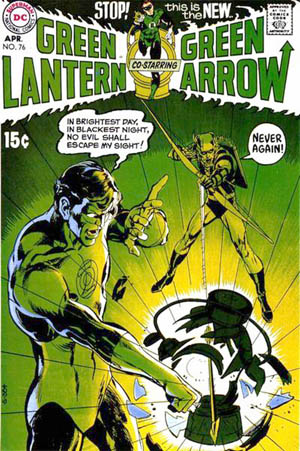 With a new costume, a new attitude and his fortune lost, Oliver Queen was now a spokesperson for an increasingly politicised set of comic books. As 1970 began, the character continued to appear in Justice League of America, helping Black Canary learn about her new sonic powers and eventually falling in love. Now far more visible in the books, he frequently gave impassioned speeches in defence of individualism (“Snapper Car – Super Traitor”, Justice League of America #77, December 1969) or environmentalism (“The Coming of the Doomsters!”, Justice League of America #78). Yet without even a regular back-up series, the character was still a supporting player in the League.
With a new costume, a new attitude and his fortune lost, Oliver Queen was now a spokesperson for an increasingly politicised set of comic books. As 1970 began, the character continued to appear in Justice League of America, helping Black Canary learn about her new sonic powers and eventually falling in love. Now far more visible in the books, he frequently gave impassioned speeches in defence of individualism (“Snapper Car – Super Traitor”, Justice League of America #77, December 1969) or environmentalism (“The Coming of the Doomsters!”, Justice League of America #78). Yet without even a regular back-up series, the character was still a supporting player in the League.
All this would change with Green Lantern #76 (“No Evil Shall Escape My Sight!”), rechristened Green Lantern/Green Arrow for the duration of its run. While steering Batman away from his campy 1960s television persona and into something darker for the Knight, writer Dennis O’Neil and artist Neal Adams began to bring about an age of what can be called “relevant comics”. Taking the classic motif of a mismatched duo – Green Arrow as the radically politicised lefty, and Lantern as by-the-book law and order regulator – the duo, along with Black Canary, set out across the heartland of America. Shifting Lantern out of his comfort zone of a space cop battling alien creatures away from Earth, O’Neil and Adams directly tackled racism, poverty, drugs, and other social ills. O’Neil remarks in his introduction to the 1983 reprint that while the stories were published in the early 1970s, “the stories belong to the previous decade as much as surely as do Owlsley Acid, the Fillmore, protest marches, draft-card burning, the Johnson Presidency and those innocent arrogant naifs, the Flower Children.” It was the start of a major shift in the direction of comics industry in the US.
It may not have been the first comic to get overtly political, indeed most of the 1940s were filled with wartime propaganda, but this was one of the first mainstream offerings to preach to a predominantly younger audience about social welfare. Yet it began as a gamble, notes Paul Levitz in 75 Years of DC Comics: The Art of Mythmaking, one editor Julius Schwartz took to help sales on the flagging Green Lantern book.
“Schwartz gave the assignment to Denny O’Neil, and added Green Arrow as a co-star and combative voice. He was joined by rising star artist Neal Adams, and together they would hit their creative peaks and forever change the voice of comics.”
While the run was undoubtedly full of some seriously goofy moments, not least of which was a little a girl with psychic powers who looked like Richard Nixon, and is rightfully accused at times of being “overwritten” and somewhat preachy, it proved that comics were not just for kids anymore. At it’s most basic level, the books pondered what would happen if a super-hero was put in a real-life setting and had to solve the problems of the world. It’s a problem that even the writers of many Superman volumes have avoided for obvious reasons, as it opens a floodgate of problems the Man of Steel cannot solve. Yet it even took on current events such as the Manson Family murders, in Green Lantern #78-79 (“A Kind of Loving”).
 Green Arrow himself bordered on becoming an insufferable jerk, so convinced of his own morals that he goes so far as to call Hal Jordan a “Nazi”. Arguably the most iconic moment in the run, beyond the one pictured above (which is one of the most reprinted panels in comics history) came in the Comics Code Authority challenging Green Lantern #85 (“Snowbirds Don’t Fly”, August-September 1971) and #86 (“They Say It’ll Kill Me…But They Won’t Say When!”, October-November 1971), in which Ollie finds that his ward Roy Harper (aka Speedy) is addicted to heroin. Rather than being a bastion of understanding, he instead slaps Roy and they go their separate ways.
Green Arrow himself bordered on becoming an insufferable jerk, so convinced of his own morals that he goes so far as to call Hal Jordan a “Nazi”. Arguably the most iconic moment in the run, beyond the one pictured above (which is one of the most reprinted panels in comics history) came in the Comics Code Authority challenging Green Lantern #85 (“Snowbirds Don’t Fly”, August-September 1971) and #86 (“They Say It’ll Kill Me…But They Won’t Say When!”, October-November 1971), in which Ollie finds that his ward Roy Harper (aka Speedy) is addicted to heroin. Rather than being a bastion of understanding, he instead slaps Roy and they go their separate ways.
In the aftermath, Ollie questions “What Can One Man Do?” (Green Lantern #87, written by Elliot S! Maggin), starting down a path that would ultimately lead him to being a newspaper columnist and run for Star City Mayor. (Green Lantern #87 was perhaps even more significant for the first appearance of John Stewart, the first African-American Green Lantern.) Here we saw a superhero not simply facing the issues of the common person in a serialised comic, and being personally affected by them, but failing to respond in the way one would deem ‘heroic’. In DC Comic Year By Year Visual Chronicle (2010), the significance of these stories is summarised:
“It was taboo to depict drugs in comics, even in ways that openly condemned their use. However, writer Denny O’Neil and artist Neal Adams collaborated on an unforgettable two-part arc that brought the issue directly into Green Arrow’s home, and demonstrated the power comics had to affect change and perception.”
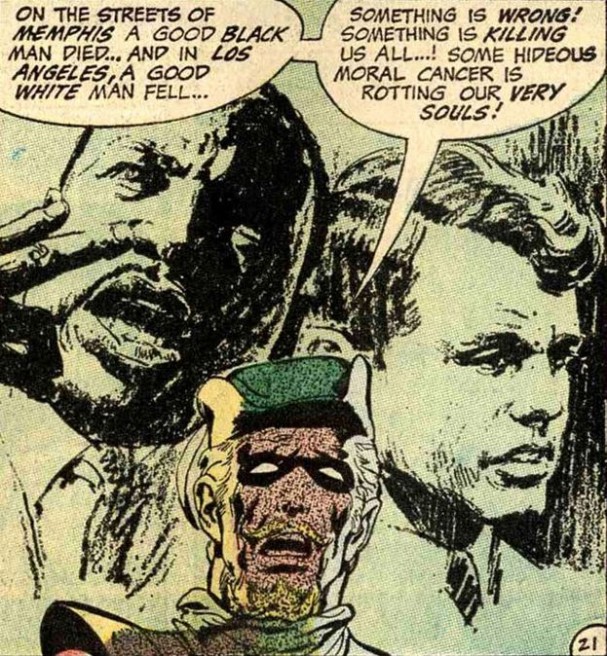 Times may have changed, and the political leanings of comic book characters may have become more subtle (for better or for worse), but few have managed to match the majesty of Neal Adams’s art on this run. The stylistic departure of the series was not simply limited to the narrative, and the super-realistic depictions of the characters were (and remain) genre defining. At times photo-realistic, and at others fantastic beyond belief, the characters behave as you would expect them to in the real world. Green Arrow had only been sporting his new look for a matter of months at the start of the series, and it would be another 25 years before it would change again.
Times may have changed, and the political leanings of comic book characters may have become more subtle (for better or for worse), but few have managed to match the majesty of Neal Adams’s art on this run. The stylistic departure of the series was not simply limited to the narrative, and the super-realistic depictions of the characters were (and remain) genre defining. At times photo-realistic, and at others fantastic beyond belief, the characters behave as you would expect them to in the real world. Green Arrow had only been sporting his new look for a matter of months at the start of the series, and it would be another 25 years before it would change again.
Editor Dick Giordano was brought back to the artists’ desk to provide the inks and enhancements to Adams’s pencils, and can also be rightfully said to be responsible for this character defining art. In Giordano’s own introduction to another (1983) collected edition of the historic run, he talks about his experiences in contributing to the books.
“I was lucky enough to be along for the ride in two ways. I was an editor at DC at the time and shared an office with Julie [Schwartz]. In addition, I was often (but not always) the inker for the series. And my work on it still ranks as some of the most exciting work I’ve done in the industry. I was overjoyed to be a part (albeit a minor one) of an event – a happening.”
Adams also won Shazam Awards in 1970 for Best Individual Story (“No Evil Shall Escape My Sight” with O’Neil), and Best Pencil Artist (Dramatic Division); and in 1971 for Best Individual Story (“Snowbirds Don’t Fly”, with O’Neil).
For its run, Ollie was cantankerous, sanctimonious and jive-talking, but it is difficult not to get swept up in the sheer enthusiasm of the book, something that has been arguably lost in modern comics. Yet with sales failing to improve, the series was cancelled with Green Lantern #89, ironically in an issue where Hal and Ollie are semi-crucified in a pseudo-religious story. Historian Ron Goulart notes the lack of sales in Ron Goulart’s Great History of Comic Books (1986, p. 297):
“All this endeared DC to the dedicated college readers of the period and won awards for both artist and writer. Sales, however, weren’t especially influenced by the praise, and by 1973 the crusading had ceased. I remember dropping in on [editor] Julius Schwartz about this time and asking him how relevance was doing. ‘Relevance is dead’, he informed me, not too cheerfully.”
O’Neil and Adams had one more story that would run throughout the pages of Flash #217 through #219, where Oliver would spend some time in an ashram monastery after accidentally killing somebody, but fans would have to wait another four years for the duo to pair up again and for the series to return. In the meantime, Green Arrow would make the shift to Action Comics and return to the wilderness of backup stories.
- Further listening: Behind the Panels Episode 12 – Green Lantern/Green Arrow (NB: pre-studio days, so sound quality is a little wobbly in parts)
The Wilderness Years: Action Comics, World’s Finest Comics and the return of the Green Team (1973 – 1979)

Action Comics #455 (1977)
Green Arrow rarely appeared on the covers of his back-up appearances during the 1970s.
There is an argument to be had that this was one of the most creative and memorable of the Green Arrow years, and yet they are probably some of the least reprinted issues in the entire Green Arrow history. For instance, in 1971’s Justice League of America #94, readers are introduced to the character Merlyn, who would become one of Green Arrow’s most fearsome foes. World’s Finest Comics #210 (“World of Faceless Slaves”, March 1972) would also continue the notion of Ollie running for mayor, something that would be picked up on later in the run.
Action Comics (December 1972 – January 1976)
Beginning in 1973, Green Arrow and Black Canary would be regularly seen in Action Comics back-up stories. Mostly written by Elliot S! Maggin, the first of these was “The Headline Maker” in Action Comics #421 (February, 1973). No longer hanging around with space cop Hal Jordan (who was appearing in backups for The Flash during this period), Ollie’s socio-political angst gave way to more personal stories, as he and Dinah entered the job market and started a life together away from the Justice League. As Ollie pursued a career in public relations, Dinah went back to running a florist as she did on Earth-2. Even though Oliver Queen suddenly came into some money in the pages of Brave and the Bold #106 (April 1973), the focus remained on the inseparable duo of Green Arrow and Black Canary.
Of historical significance was the presence of Dick Dillin and Dick Giordano on art duties, and later in the run, an artist named Mike Grell (who had only been with DC for a few years) would take over with Action Comics #440’s “Little Dog Lost!” (October 1974), where he would stay until 1976. This would plant the seed for his historic The Longbow Hunters and subsequent character defining run throughout the 1980s and early 1990s. Yet as writer, Maggin brought a lot of heart to the character, softening the radical somewhat during this period. In a piece by Jim Kingman in Back Issue #64 (May 2013), Maggin notes his interesting take on the character:
“I liked Green Lantern as a character better…and Denny [O’Neil] preferred Green Arrow., but it was Julie [Schwartz]’s perception that GL was the principal character and Denny was the more experienced writer. If it had been either of our decisions, it would have been the other way around. Julie was a little amused that I patterned the Arrow’s speech patterns after a parody of my own. I spoke fluent ’70s New York wieseass in those days.”
Green Arrow and Black Canary would fight and make up just as quickly, and as Grell put it in the same interview “they were the only couple in comics at that time that actually slept together.” Their relationship would form the basis of a body swap issue with Zatanna in “Magic is Bustin’ Out All Over!” (Action Comics #437, July 1974), one of the first lead stories in the book, and again take centre stage in “Junkman – the Recycled Superstar” (Action Comics #455, July 1974). The Action Comics run would last until April 1976, where the three-part “Nutty Kid” saga would conclude the back-up appearances in that title.
World’s Finest Comics and the Return of the Green Team
Gerry Conway, along with Bob Haney and Mike W. Barr, carried the character over to World’s Finest Comics for one of the lengthier back-up series featuring Green Arrow. It began with Worlds’s Finest Comics #244 (May 1977), in which “Rainbows of Doom” and “Slings & Arrows” saw Black Canary and Green Arrow get their own stories respectively, going up against the likes of the Rainbow Archer and Slingshot. It went all the way through to World’s Finest Comics #283 (September 1982). Yet it was not a homogeneous beast. Like Jack Kirby during the early Silver Age, Conway’s run (World’s Finest Comics #244-263) populated the Green Arrow world with science fiction elements, and villains like the Clock King and Auntie Gravity. One of the most famous villains of all time came out of this run, with the introduction of the unbalanced Count Vertigo making a solid addition to Ollie’s rogues gallery.
Ollie was still fighting the good fight, but the relationship with Dinah/Black Canary became the central story. Later in the World’s Finest Comics run, which we will discuss more as we move into the 1980s in the next installment, Haney and Barr would deliver more O’Neil-esque stories, albeit filtered through this Conway period. Continuing the idea that Oliver could do some good as the mayor of Star City, Elliot S! Maggin wrote a sequel to the “What Can One Man Do?” story from Green Lantern/Green Arrow #85 in the pages of World’s Finest Comics #255 (February/March 1979). Entitled “Nothing But a Man”, it sees Ollie losing the election thanks to the meddling of the Crime Syndicate. In an interview with Jayme Lynn Blaschke, on the now defunct Green Arrow Fansite, Maggin reminisces on the origins of that stand-out story:
“I wrote “What Can One Man Do?” as an inspired amateur. By the time, eight years later, I wrote “Nothing But a Man,” I had been a professional writer for sometime and the work had passed from diversion to … work. There were all sorts of political repercussions to everything I did and said, it seemed, and I had gotten into this frame of mind where I stepped out of myself once in awhile to look at my life and personal fortunes objectively. I think that, with Green Arrow as my personal Everyman, that was what I was expressing in “Nothing But a Man.” It was my last Green Arrow story, and I intended it to be. When I wrote the first one, I was a junior in college in the middle of an election of my own. I was running for President of the Student Council. As it happens, I won. Or so I learned about six months later. A friend who was an officer of the Student Council at Brandeis was apparently funnelling money into some personal expenses, and it was his judgment that he would be found out if I were elected. So he contrived to get someone he considered more malleable elected — without that person’s participation in this little voter fraud. This was all real life…So years later, when I wrote the story of the upshot of my first Green Arrow story, I was actually telling the story of what was going on with me during the time I wrote that first story”.
With Ollie’s quest to become mayor unsuccessful, one of Conway’s final contributions for the decade was the “One Man Can Cry” story (World’s Finest Comics #258, August/September 1979) where Oliver accepts a job offer to write a column for Daily Star’s editorial column. This would set up Oliver Queen’s next platform for being vocal through the Detective Comics run of the 1980s.
Running concurrently with this World’s Finest Comics arcs was the return of Green Lantern, beginning with #90 in September 1976 after a four year absence. Unlike today, where the book would be most likely be rebooted and renumbered, this simply continued as though the friends were off on a new adventure. The return was heralded with a big logo on the cover proclaiming “At last…the return of the greatest comic of them all!”, although the second series would not be as well received. Despite being written by Denny O’Neil, most of the stories in this revived run – that ran until Green Lantern #122 (November 1979) – were fairly forgettable. Case in point was the first issue of this new run, which saw the green team going up against a previously unheard of group of proto-Lanterns, ones that were not mentioned again in the decades that followed.
With more of a focus on sci-fi and less on being “relevant”, these books are mostly significant for the creators, who initially included Mike Grell and eventually Alex Saviuk (a name that would later be familiar to Spider-man fans). From the sublime to the ridiculous, the low point was perhaps the appearance of Itty, a sentient alien plant that Hal Jordan kept as a pet. However, there were a few gems in this series, including the two-part “Lure of an Assassin”/”Terminal for a Tragedy” in Green Lantern #94 and #95, in which Ollie shaves the beard and employs some rarely seen detective skills for a spot of undercover government work while Lantern is out with the flu.
 Perhaps indicative of how little these issues are regarded is that they have never been included in any of the plethora of reprints of the Green Lantern/Green Arrow runs. Indeed, collectors of this era have slim pickings in the way of collections, with virtually none of the backup stories or second series of Green Lantern/Green Arrow gathered together in any form. Even the effective survey Green Arrow/Black Canary: For Better or For Worse (DC Comics, 2007), containing a decent sampling of stories from this era, has gone out of print. Other gems to look out for “A Gold Star for the Joker” in Joker #4 (November/December 1975) and “The Day Time Broke Loose” in Wonder Woman #217 (April 1975), where Ollie is on the lookout for a fake Green Arrow!
Perhaps indicative of how little these issues are regarded is that they have never been included in any of the plethora of reprints of the Green Lantern/Green Arrow runs. Indeed, collectors of this era have slim pickings in the way of collections, with virtually none of the backup stories or second series of Green Lantern/Green Arrow gathered together in any form. Even the effective survey Green Arrow/Black Canary: For Better or For Worse (DC Comics, 2007), containing a decent sampling of stories from this era, has gone out of print. Other gems to look out for “A Gold Star for the Joker” in Joker #4 (November/December 1975) and “The Day Time Broke Loose” in Wonder Woman #217 (April 1975), where Ollie is on the lookout for a fake Green Arrow!
While the Green Lantern would go back to being a solo title from issue #123, Arrow fans wouldn’t have to wait long for further adventures of the Emerald Archer. The ongoing World’s Finest Comics would spill over into the 1980s, where a significant run on Detective Comics began. Yet what Green Arrow was still missing, almost four decades into his existence as a character, was his very own series. This would have to wait until 1983, when Mike Barr would tackle the very first Green Arrow mini-series. All of this will be the focus of Part 3 of our comprehensive History of Green Arrow.
Beyond the Comics: “Great Flaming Arrows!”
Until the 1990s, Green Arrow didn’t have much of a presence beyond the printed page. However, like every other super hero on the block, he was turning up on merchandise, toys and even his very own episode of a cartoon. Green Arrow’s only television appearance prior to 2004’s Justice League Unlimited was in the 1973 Super Friends episode “Gulliver’s Gigantic Goof”, Green Arrow was voiced by Norman Alden. Spouting catchphrases like “Great flaming arrows!” and “By Robin Hood’s bow!”, his fame was short lived. Check out a clip from the episode below:
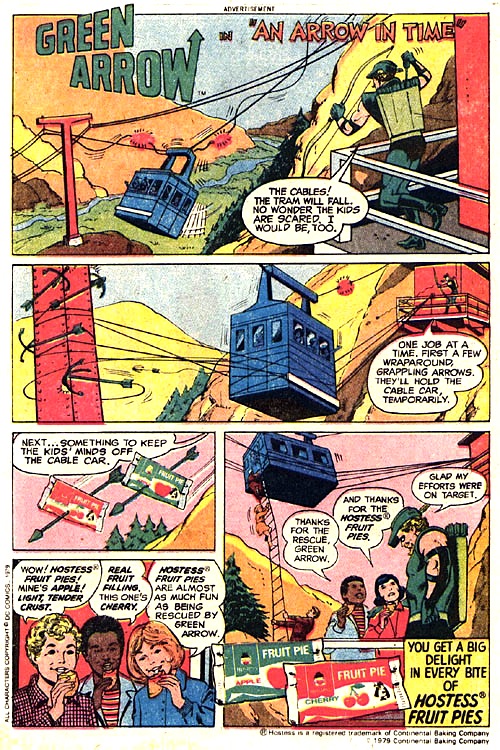 He may not have appeared in the show again, but he did show up on the hard-to-find 1976 Super Friends lunchbox set (pictured below). There was bootleg merchandise in bow and arrow sets, Slurpee cups and gum. Yet the most sought after item from the era would be the original Green Arrow Mego figures. The last of the 8″ figures, the Mego Museum notes that “it is a consensus within Mego collecting circles that Green Arrow is the finest WGSH figure ever produced”. Even harder to come by is the accompanying Arrow Car (both pictured below), which fired missiles and generally looked cool with decals clearly indicating who the car belonged to.
He may not have appeared in the show again, but he did show up on the hard-to-find 1976 Super Friends lunchbox set (pictured below). There was bootleg merchandise in bow and arrow sets, Slurpee cups and gum. Yet the most sought after item from the era would be the original Green Arrow Mego figures. The last of the 8″ figures, the Mego Museum notes that “it is a consensus within Mego collecting circles that Green Arrow is the finest WGSH figure ever produced”. Even harder to come by is the accompanying Arrow Car (both pictured below), which fired missiles and generally looked cool with decals clearly indicating who the car belonged to.
Back on the printed page, Green Arrow was not adverse to lending out his visage for the corporate sponsor, despite his radical views in the comics themselves. Hostess ran a series of ads for their products in comics starting from 1975, including both Marvel and DC characters in their various ads. (FACT: Daredevil loves peaches). Tailored to their audience, Green Arrow only made a single appearance in one of these advertisements, hocking Hostess Fruit Pies in a one-page story called “An Arrow in Time” (1979). Pictured left is one of the original ads as it would have appeared in the comics. Fans looking for a comic that might have this ad inside could start with Weird War Tales #86, Wonder Woman #266, Adventure Comics #471, Batman #335, Legion of Superheroes #262, Sgt. Rock #339, Unexpected #198 or Green Lantern #128
In Part 3, we’ll continue to follow Green Arrow through the back-up stories of the 1980s, along with the start of his own mini-series, his recipes for success and that time Frank Miller cut off his arm.
>>Proceed to Part 3>>
Agree or disagree? Got a comment? Start a conversation below, or take it with you on Behind the Panel’s Facebook and Twitter!
If you are an iTunes user, subscribe to our weekly podcast free here and please leave us feedback.






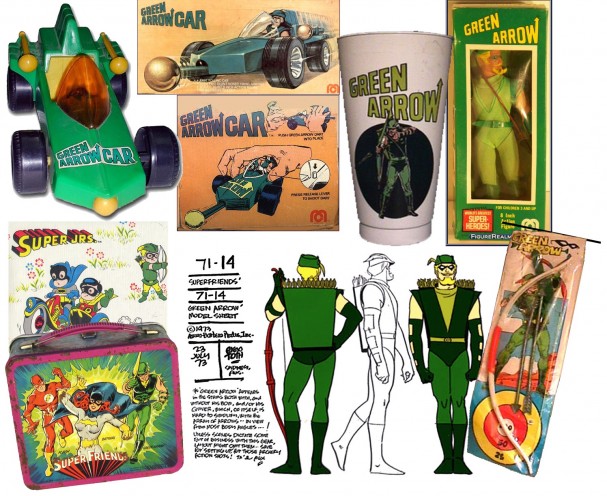

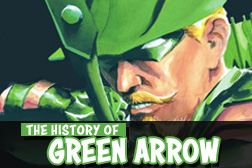







9 pings
Skip to comment form
[…] The History of Green Arrow Part 2 – Hard Travelling Through the Wilderness Years (1970 to 1979) […]
[…] The History of Green Arrow Part 2 – Hard Travelling Through the Wilderness Years (1970 to 1979) […]
[…] The History of Green Arrow Part 2 – Hard Travelling Through the Wilderness Years (1970 to 1979) […]
[…] The History of Green Arrow Part 2 – Hard Travelling Through the Wilderness Years (1970 to 1979) […]
[…] Part 2, we’ll unpluck the infamous Green Lantern/Green Arrow run from Denny O’Neil and Neal […]
[…] in the landmark series Green Lantern/Green Arrow. A great description of that run can be found here. (That’s also a good place to check out the trademark goatee that Adams gave to Green […]
[…] with the foldees sold inside gum packets. One of the most highly sought-after figures are the 1974 Green Arrow Mego line, fetching hundreds of dollars in online auctions. The range has expanded somewhat over the years, […]
[…] The History of Green Arrow Part 2 – Hard Travelling Through the Wilderness Years (1970 to 1979) […]
[…] or are as big a fan as Richard, you’ll know that Mike Grell not only worked on the classic Green Lantern/Green Arrow run of the 1970s with Denny O’Neill, but reinvented the character as an urban hunter […]